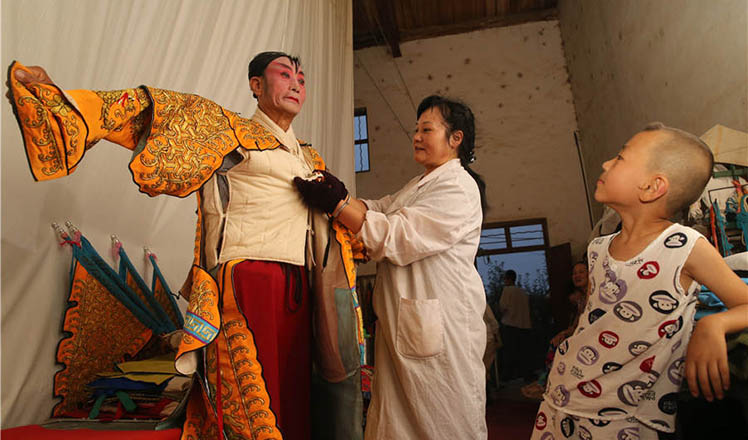ASEF Summer University: connectivity between Asian and Europe
Updated: 2016-08-22 09:40
(chinadaily.com.cn)
|
||||||||
Connectivity should include not only the construction of hardware, but also the soft part, said a senior official for China of the Asia-Europe Meeting on the sideline of the Asia-Europe Foundation Summer University.
This year's edition kicked off on August 15, 2016 at Beijing Jiaotong University, and also welcomed its 20th anniversary. In coordination with the One Belt One Road Initiative, connectivity became the key word of this year's summer university.
"Connectivity was determined as a priority at this year's Asia-Europe Meeting Summit," Ambassador Xie Bohua from the Ministry of Foreign Affairs commended on this year's theme, which is "Gateways of Asia and Europe: Connectivity by Land, Sea and Air".
"We want to combine the theme with One Belt One Road Initiative. The six cities we will go are all along the path of One Belt One Road, and many of the ASEM member states are also by the side of it. So the summer university will be a great opportunity," Xie continued.
"We also want to provide the participants chances for communication, help them build connection, and probably seek future opportunities of corporation," added Ambassador Zhang Yan, the Executive Director of Asia-Europe Foundation.
Known as One Belt One Road Initiative, The Silk Road Economic Belt and the 21st-century Maritime Silk Road is a development strategy and framework proposed by President Xi Jinping in 2013. It highlights five areas of connections, including policy coordination, facilities connectivity, unimpeded trade, financial integration and people-to-people bonds.
Within two weeks, 48 representatives from 47 member states will visit six cities in China, Russia and Mongolia, studying how the connectivity can enhance the cultural exchange, trade and common development.
"Portugal has really great relations with China. As we are connected, there are so many cultural and business exchanges," said Rita Lousa, a 21-year-old designer from Portugal, who also found the summer university as a platform to meet more people in different fields. "It's creating a lot of new jobs in Portugal," she laughed.
Olivier Danenberg, a communication professional from Belgium, said it would be interesting to share experiences with the other participants to see how their own country is dealing with transportation and connectivity. "I will take the experience back home and try to see how we can best implement the solutions locally," he expected.
"We will have a number of presentations, discussions, site visits, and we try to develop policy proposals on how to improve connectivity," Olivier also mentioned.
According to Zhang, participants will be divided into different groups discussing given topics, such as how to make the public transportations more disability-friendly, how to prevent terrors on public transportations, and how to control the spreading of infectious disease through public transportations.
"It's not only the transportation factor, but also the human factor that attracts me," German Nora Reinolsmann agreed that she wished to improve the connectivity between Asia and Europe. "I really would like to do something within Asia-Europe transportation field. So why don't we have an entrepreneur thing. Maybe we can stay in contact, set up some project even for the future."
And this was exactly the expectation the organizers had for the summer university.
"No matter whether it is One Belt One Road or connectivity, the key point is human, the communication," Xie answered regarding the question of future challenge.
Starting from Beijing and then Harbin, these young fellows could see how fast China develops on the infrastructureconstruction in the sea, land and air. "They will know China better," said Liu Jun, vice president of Beijing Jiaotong University. "They will have a better understanding of the One Belt One Road."
"I do hope the experience will inspire them to become the contributor and promoter for both the One Belt One Road Initiative and the connectivity," Xie concluded.

 Goodbye, Rio; hello, Tokyo
Goodbye, Rio; hello, Tokyo
 The world in photos: Aug 15- Aug 21
The world in photos: Aug 15- Aug 21
 Kickboxing and throwing punches: Welcome to flight security training
Kickboxing and throwing punches: Welcome to flight security training
 Qinqiang Opera actors brave heat to bring smile to faces
Qinqiang Opera actors brave heat to bring smile to faces
 Top 10 cities with highest GDP in H1
Top 10 cities with highest GDP in H1
 Chinese teenagers take gold, silver on 10m platform
Chinese teenagers take gold, silver on 10m platform
 US granted re-run to send China out of relay race
US granted re-run to send China out of relay race
 China inches toward gold after beating Netherlands
China inches toward gold after beating Netherlands
Most Viewed
Editor's Picks

|

|

|

|

|

|
Today's Top News
Trump outlines anti-terror plan, proposing extreme vetting for immigrants
Phelps puts spotlight on cupping
US launches airstrikes against IS targets in Libya's Sirte
Ministry slams US-Korean THAAD deployment
Two police officers shot at protest in Dallas
Abe's blame game reveals his policies failing to get results
Ending wildlife trafficking must be policy priority in Asia
Effects of supply-side reform take time to be seen
US Weekly

|

|







